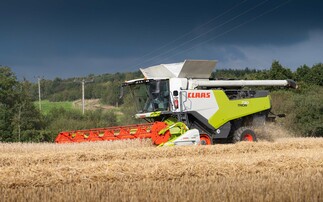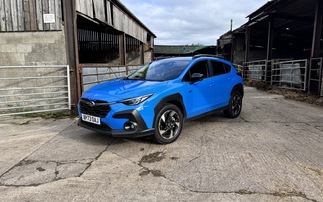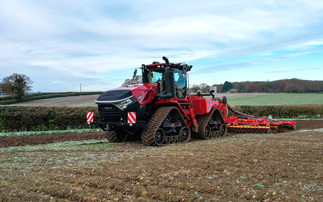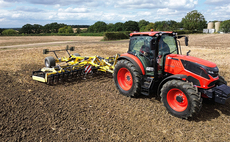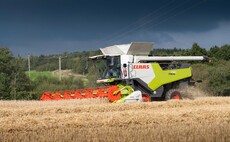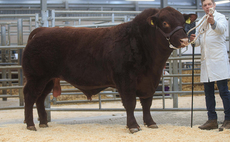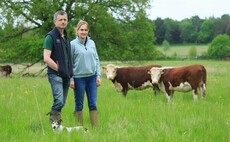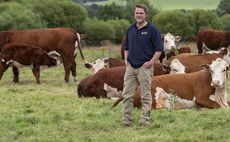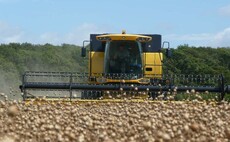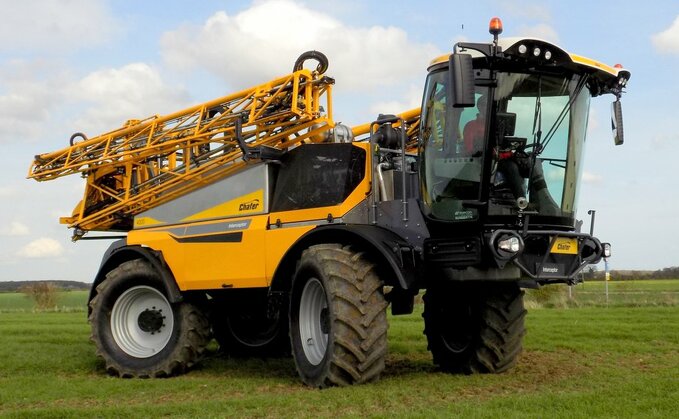
Not wanting to rely only on sales of its trailed sprayers, Chafer is back in the self-propelled market with the development of the Interceptor. James Rickard finds out more.
Following several years without a self-propelled sprayer of its own, Chafer is now back in the market with the introduction of its new Interceptor and Defender models.
Previewed at the 2016 Cereals and 2017 Lamma events, the introduction has been largely driven by customer demand. But with such a strong line-up of trailed sprayers, why create one at all? Managing director, Rob Starkey explains; "In 2016 the total trailed market accounted for 178 machines, which has been steadily declining since its peak in 2008 of 334 machines.
"The trailed market has also seen a large influx of competition, especially from large manufacturers wishing to expand their product portfolios, resulting in tighter market shares for everyone. While our market share in this segment is growing, it is still a falling market."
"As such, we need to be in the self-propelled market, which accounts for nearly 400 new machines sold per year, a figure which has remained steady for the last five years."
As well as completing Chafer's sprayer offering, the manufacturer hopes the new products will open up new market opportunities. However, rather than just coming to the party with another ‘me too' product, Chafer has identified a gap in the market between British-made light and compact machines and Europe-made larger, more high-tech machines.
The result is the Interceptor, with a simpler and smaller version still to follow, the Defender. Particularly with the higher-spec and larger capacity Interceptor, Chafer hopes it can target both ends of the self-propelled sprayer market by offering the latest technology and high output, but in a relatively compact package.
lead pic 2

Compact dimensions were a big part of the Interceptor's design criteria.
Powertrain and running gear
At the heart of the Interceptor is a six-cylinder, 6.1-litre Deutz engine. Capable of 242hp, the unit is tuned to 215hp, leaving plenty in reserve. Coupled to this is a Bosch Rexroth hydrostatic transmission featuring individual wheel motors.
To operate, one of two modes can be selected; manual or Eco. The latter behaves much like a CVT in a tractor, with the Interceptor's engine and transmission working together to decide what revs are needed to achieve the desired forward speed. This comes into its own where terrain rises and falls which sees an inclinometer used to automatically regulate engine revs and the hydrostatic motors to maintain a constant forward speed.
When on the flat, or descending a hill, engine revs will continue to drop until it reaches a minimum operating speed of 1,500rpm, maintaining application consistency. On the road, it can achieve top speed at 1,300rpm.
engine bay pic
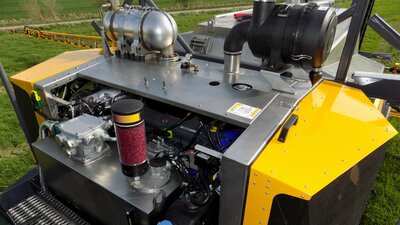
Engine bay access is good.
powertrain copy 2
When controlling speed with the ‘stick', all deceleration is done within the hydrostatic transmission without over revving engine. For more powerful braking, a pedal can be used which uses hydraulic resistance in the transmission for the initial braking phase, then disc brakes are applied in each of the wheel motors for the final phase. In addition, the individual wheel motors offer traction control, differential wheel speeds, and hill climb and decent modes.
Ease of service has been carefully considered with plenty of space to get at the engine bay and hydraulics. Engine service intervals are 500 hours as standard, but with oil sampling this can be considerably longer. Also, a handy water separator in the hydraulic tank keeps on working even when the machine is not running. When the filter changes colour, it is time to change the filter.
Underpinning the Interceptor is an in-house designed running gear featuring a ladder-type chassis, load-compensating air suspension and solid axles with manual track width adjustment - hydraulic adjustment is to come.
Various drop leg options are available offering a maximum ground clearance of 1.1m, when fitted with 600/60 R34 tyres.
undercarriage pic

Various drop leg options are available.
Cab
Before we get too excited with the cab, the current pre-production cab frame seen here is going to be swapped for a cab built by New Holland, which will come with its own control console, rather than having it to be added separately as it is done now.
The New Holland-sourced controls, as used on the pre-production machine, offer a clear and easy-to-use layout, with proportional control over speed. Integrated into the head of the main joystick is a bank of switches for manual section control, while three separate screens take care of sprayer control, plumbing control and powertrain status. In the near future, Chafer is going to integrate the latter two screens into one, tidying up the cab.
For spray control, automatic steering and job documentation, TopCon is Chafer's preferred partner, which can supply a full suite of integrated components, backed up by UK distributor LH Agro. This includes its latest touch screen X35 terminal, its two-in-one receiver and steering controller (which can be switched between machines), auto-steer hydraulic block and Apollo multi-line spray controller.
cab pic
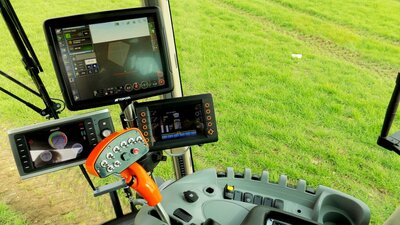
Three screens will eventually become two.
cab copy 2
However, the Interceptor has been designed with enough of an ‘open platform' to allow customers to choose their preferred precision farming partners.
The X35 screen also offers remote support and an ‘extend' feature which allows a tablet or smart phone to share some of the X35 screens' work. This could let you monitor more information in-cab, for example, or enable you to externally control spray functions, great for setting up nozzles.
There is also a good space between the cab and the engine bay which provides good access and reduces heat and noise transfer to the gab. While engine noise levels are remarkably quiet, a transmission whine still manages to permeate into the cab. This may be addressed with the New Holland cab.
remote pic
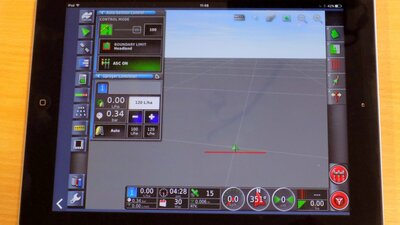
TopCon can offer remote access of its systems.
Plumbing and boom
Particularly with the spray pack, a lot of tried and tested technology is adapted from the firm's trailed machines including plumbing, booms and control systems.
There is a choice of manually- or electronically-controlled plumbing systems. The top-spec ePlumbing option affords control from both inside and outside the cab, automated filling and cleaning and is compatible with vari-rate control. It also features a diluting function which is great for finishing off a field by using up spare chemical mixed with clean water. Its smart control screen should cut down on human error, with clear symbols used to select various functions.
As with all Chafer sprayers, the Interceptor comes ready to apply chemical and liquid fertiliser. Up to 20, air-operated sections can be specified, or Hypro's Prostop e individual nozzle control system can be specified, which uses electrically-actuated valves, eliminating multiple airlines, tidying up the boom. Its modular design allows the modules to be quickly fitted and/or changed.
plumbing pic
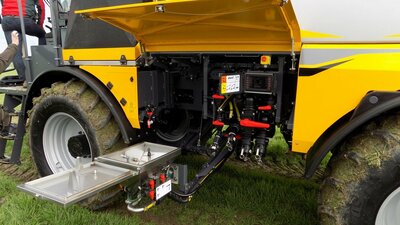
Plumbing is very similar to Chafer's trailed machines.
plumbing copy 2
Based on a mast design, a new sliding frame has been introduced which offers an increased range of movement (see specifications). As standard, the Interceptor is equipped with automatic boom control of height and tilt/incline, all of which is customisable from the cab.
A new headland lift feature, picks up the tips of the booms, to prevent ground collisions, and a sub-zero function allows the booms to lower below the centre section, over the crest of a hill, for example.
Chafer is steadfast that steel tanks are the best option, with the ability to weld baffles, better to clean and they last. Part of the tank is also sunk into the chassis, keeping the centre of gravity down and providing a deep sump for suction.
nozzle pic
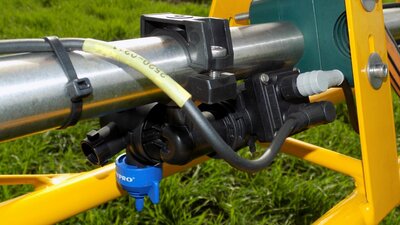
Individual nozzle section control can be specified.
Verdict
While our pre-production machine allowed us to get a flavour of the new Interceptor, it is still not quite the finished article, particularly the cab.
However, it did show that Chafer has put a lot of thought into the design with some very smart touches including a low revving engine concept, its ePlumbing system and ease of maintenance.
It is also a smart move by the firm to go for the mid-market, with a product which appeals to a wide variety of end users.










